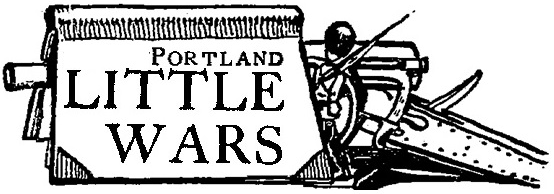Continuing on with General Jovinus' campaign against the invading Alamanni in 366, here is a game based on a second surprise attack by the Romans upon the Alamanni.
...one of his scouting parties report that 'after plundering the neighboring farmhouses a predatory band was resting near the river': unfortunately [chronicler] Ammianus does not name the river. Advancing with extreme caution, Jovinus managed to bring his troops to the edge of the valley, where: 'Hidden in a valley concealed by a thick growth of trees, he saw that some were bathing, others were reddening their hair after their national custom, and still others were drinking.' Preparing his troops, Jovinus suddenly gave the signal, and his men rushed the enemy camp. Taken completely by surprise, the majority of the Alamanni were killed, while a few escaped by taking refuge along the 'winding and narrow paths' in the area.
- Hughes, Ian. Imperial Brothers: Valentinian, Valens and the Disaster at Adrianople (2013).
So a similar set-up to Scarponna, but with a river this time. Since this was yet another remote game and involved a grid, we decided to give ruleset The Portable Wargame (or, more specifically, Developing the Portable Wargame, since that is where the ancient rules are located) a try.
 |
| Positions after the first turn: the Alamanni are positioning to defend themselves on the far bank of the river, while Romans advance from left. |
We played with 10 units per side at exactly 46 strength points each, for an army exhaustion point of 15. Because I had laid out a grid of 3" squares on my game mat, each unit straddled two squares, and movement and ranges were doubled. Although this mostly worked fine, the one-unit-on-two-squares element made for some tricky melees, since units could combat with only one square each touching.
 |
| Roman right flank advancing. |
 |
| The Roman general behind the Roman left flank. |
As players of The Portable Wargame know, each side will fight until it has lost 1/3 of its total strength points, at which point it cannot move towards or charge the enemy anymore. These strength points are tallied across the entire army. So losing 15 strength points does not mean losing 4 units (of 4 SP each). Instead, five units could lose 3 SP each, which would mean that none of them would be removed from the table, but that the army had still lost its fighting nerve.
 |
| Cataphracts attack an Alamanni unit in its flank. |
 |
| The Alamanni chief in combat against Roman heavy cavalry. |
 |
| Roman infantry finally crossing the river and joining in melee. |
When the Roman infantry finally did get close enough, the various cavalry had accumulated too many lost SPs. One attempt was made at a sort of combined attack - one infantry unit retreating a square and throwing javelins, followed by archer fire at the same target, and then a 2nd infantry unit closing for the melee. In theory this could have resulted in 3 SP lost on the target Alamanni unit in quick succession. Instead, it escaped completed unscathed!
 |
| Roman cavalry in a messy situation on the Alamannu right flank. |
 |
| After the death of the chief. |
So in one swoop the Alamanni lost 8 SP which put them well over the exhaustion point. We finished the Romans' turn and gave the Alamanni another turn to resolve existing melees and some shooting attacks, which caused the Romans to reach their exhaustion point as well. As both sides had lost one unit but the Alamanni had also lost their general, we agreed it was a Roman win that they could feel good about. Next time we will have some victory point criteria in place.



No comments:
Post a Comment